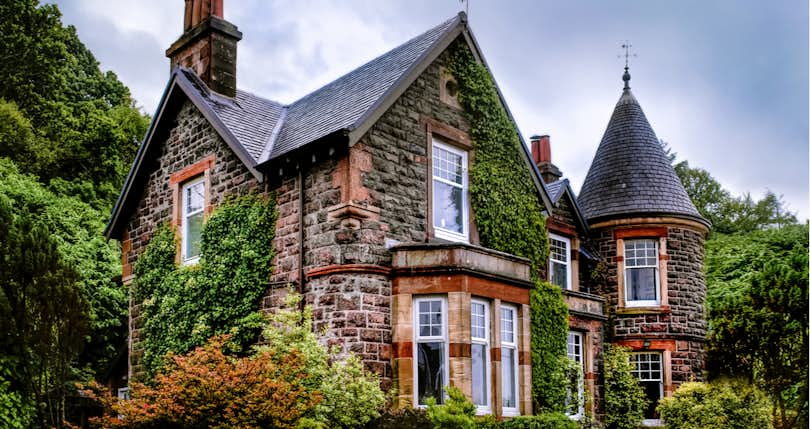| Note: When you work with one of our partners, we may earn a small commission. Learn more about our editorial policy and how we make money. |
Enchanted by the charm and beauty of an old home? If you're considering buying a 100-year-old house, it's important to know what you're getting into. Outdated materials and poor foundations can lead to disaster. Here are seven things you should know about buying an old house.

Many people dream of owning an old Victorian home or a little piece of history in a small town. It's easy to see why the beauty of an old home can enchant. However, if you fail to thoroughly inspect and understand the property you're purchasing, your dream home could quickly become a nightmare.
While older homes can beautiful and ornate, they also are built with materials that are no longer considered safe. Sometimes, the materials within an older home are now illegal. Also, how older homes are wired can often put your family in danger.
It's normal to expect that you must incur some repair costs when you purchase an ancient home. However, if you're not careful, the cost of renovating and updating the home could quickly become overwhelming.
Before you sign on the dotted line, it's important to consider the following seven factors. While this is not an exhaustive list of everything you should consider, it should put you on the right track to thoroughly evaluating the home you're considering purchasing.
Be sure to work with your real estate agent to make sure that your understanding of the property's true condition is accurate. A local, experienced real estate agent can help you navigate the home buying process and ensure you've covered all your bases for ensuring the charming old home of your dreams is a safe investment.
Thinking about buying a 100 year old house?
Work with a Partner Agent before signing to ensure everything's in order.
Check the Paint
One of the most common repairs that made by people who purchase an older home is to strip out lead paint and replace it with safer alternatives. It used to be that using lead paint was acceptable. However, science later revealed that lead paint is toxic, especially to developing children.
In response to this knowledge, it's now illegal to have lead paint in your home. This is a federal law that affects every state in the country. While the seller is legally required to let you know if there is any presence of lead paint in the home, sometimes this doesn't happen. The responsibility also lies with you to ensure that the home you're purchasing is safe.
If you don't want to deal with replacing the lead paint, since painting over it doesn't remove the threat, then you'll want to look for a home that has already had the paint replaced. At the least, even if you don't mind doing that repair yourself, you must ensure that you know what you're getting into. Always be sure to get the home inspected for lead paint before you sign.
Look at the Outlets
As you walk through the home, be sure to check the outlets. Ungrounded outlets are easy to detect by looking at the number of holes in the outlets. If the home's outlets have three prongs that form a little triangle, you're safe.
However, if there are only two prongs, you're looking at a potential for steep electrical repairs. Ungrounded outlets pose a serious fire risk. Beyond that, most modern equipment, such as televisions and laptop chargers, all require grounded outlets, so nothing you bring in will work unless you change the electrical system.
Ungrounded outlets aren't a deal breaker, but you will have to make some major repairs to them before you can safely move into the house and use your electronic equipment.
Look for Other Electrical Issues
Ungrounded outlets represent only a portion of the electrical issues you could face when buying an older home. People who lived 100 years ago used far less electricity than we do now. Even 60 years ago, the use of electronic equipment was significantly lower than it is now.
Because of this, you might find that your charming old home hasn't quite kept up with modern requirements. Have an inspector thoroughly check the electrical system to ensure it can handle the load your electronic devices will place on it.
For some old homes, even flipping on a light switch can reveal serious issues. Make sure you fix all the electrical issues and ensure your house is fire-safe before moving in. If major repairs are necessary, factor that into the cost of the home.
Find Local Electrical Pros. Get Up to 4 Quotes Now. It's Quick, Free, and Easy!![]()
Be Mindful of Structural Considerations
Some structural damage to the home will be apparent just by looking at it. That porch didn't end up sideways on purpose. But other forms of structural decay can be invisible to the naked eye unless you know what you're looking for.
It's important to check the foundation of the home and the sills. Old sills can lead to water damage that can quickly add up to enormous repair costs. A cracked or damaged foundation can lead to structural collapse if not taken care of quickly.
Structural and foundation-related repair costs are some of the most expensive, so obtain an accurate estimate of any structural repairs you must conduct before you purchase the home.
How's the Water?
Of all the repairs you might expect from an old home, updating the water source might not be the first one on your list. In fact, many home buyers don't even realize that outdated water sources can be a problem at all.
However, until modern times, shallow wells were often used as water sources. These wells were usually dug by hand. In contrast, modern water systems drill deep to access purer water that's safer for drinking, bathing, cooking, and other routine activities.
If the home you're considering uses a hand-dug, shallow well, you could invite a host of bacteria and other contaminants into your home through the faucet. Be sure to have the water situation appraised by a professional and take any necessary upgrades into consideration as you decide whether the older home in question is worth the cost.
Look Up
It's no surprise that the roof of an old home has seen some damage. This is particularly true if the home has sat abandoned for a long period. Missing shingles, obvious gaps, and even more subtle forms of roof damage can lead to serious leaks and future water damage.
Look for signs of water damage that already exist, such as moss. You might think moss adds a charming element to the home, but unless you're living in the world of a fairy tale, that beautiful greenery is a warning sign.
Make sure you hire a roof inspection so you can obtain an estimate of how much you must spend to bring the roof up to par.
Find Pre-Screened Top-Rated Roofing Contractors! Get Bids & Review Today!![]()
Uninvited Guests
The longer a home has sat in disrepair, the more likely it is that the local pests have taken up residence there. Sometimes, the presence of pests like mice, cockroaches, and other critters is relatively obvious. Other times, you must look a little closer to see them.
A common problem that people who purchase old homes have to deal with is removing pests from the walls. Spend enough time online looking up old home horror stories, and you'll hear countless reports of unsuspecting families who moved in, settled down, and soon began to hear running in the walls.
Leave the infestations to horror movies and get your home thoroughly inspected and, if necessary, fumigated (or otherwise exterminated) before you move in. Pest removal and maintenance costs are also something you'll want to factor into the overall price of the home.
There's nothing wrong with buying an old home. They're charming, full of character, and often hold historical significance in the towns they're located in. Rather than trying to discourage you from buying an old home, the information above is a guide to help you evaluate the true condition — and cost — of buying the 100-year-old home you're looking at.
Be sure to work with an experienced, local real estate agent. They'll make sure you avoid common pitfalls, ask the right questions, get the right inspections, and have a realistic expectation of what purchasing and renovating the home will cost.



